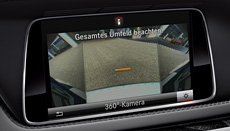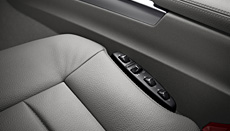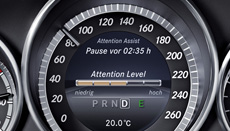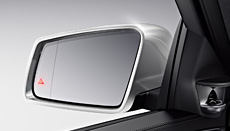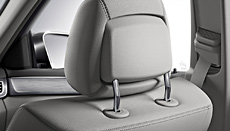

The Integral Safety Concept from Mercedes-Benz divides vehicle safety into four phases:
Virtually no other area inspires the Mercedes-Benz engineers to produce such consistently impressive results as much as research into new safety technologies. The first important safety milestone was reached back in the 1950s with the development of the passenger safety cell, invented by Béla Barényi. Today it is just one of many components of the Integral Safety Concept which edges Mercedes-Benz vehicles ever closer to our vision of accident-free driving.
Phase 1: safe driving
The majority of accidents start long before the actual collision: with a lapse in concentration, poor visibility or hazards which cannot be anticipated. That's why the Mercedes-Benz safety concept employs a range of measures to support safe driving in everyday operation and to help you bring critical situations under control.
The 360-degree camera system displays the vehicle's surroundings from a bird's-eye perspective on the screen of the COMAND Online multimedia system. As all four sides of the vehicle are monitored, it is easier to assess the situation in any manoeuvre. The system comprises a short-range camera system with four cameras and a control unit, which together can provide a bird's-eye view of the vehicle and its surroundings One camera is fitted in the centre of the radiator grille at the front, one camera is fitted in each of the exterior mirrors and one camera is fitted in the centre of the boot lidThe 'virtual viewpoint' created by the camera images covers an area of about three metres in front of the vehicle and behind. The image is displayed on the head unit screen.
| |
DISTRONIC PLUS proximity control helps the driver to maintain a specified (timed) distance from the vehicle ahead when travelling at speeds of 0 to 200 km/h. Extended functionality through incorporation of the new STEER CONTROL function is now additionally based on the lane markings, helping the driver to keep in his lane. Implementing BAS PLUS Brake Assist in conjunction with the PRE-SAFE® brake system helps to avoid rear-end collisions more effectively. If radar sensors identify a potential collision and the driver applies the brakes, BAS PLUS is primed to apply a brake force commensurate to the situation and available stopping distance. In the new E-Class the BAS PLUS function has been expanded to include for the first time crossing objects and pedestrians, something that is particularly relevant at intersections.
| |
The Active multicontour seats for driver and front passenger feature separately controlled air chambers, which can be configured to suit individual physiognomic requirements. The seat side bolsters adapt dynamically and automatically to the driving situation. Seat cushion depth, seat side bolsters and lumbar support can all be adjusted pneumatically. Additional comfort is provided by a dynamic massage function in seven zones. This is one of many reasons why the Active Multicontour Seats were awarded the quality seal by the "Aktion gesunder Rücken e. V." ("Campaign for healthy backs"), which is awarded to products that are particularly "back friendly".
| |
Active Parking Assist helps the driver when searching for a parking place and when parking. With its ultrasound sensors the system can detect whether a lengthways or side-on parking space is large enough. Active Parking Assist makes a major contribution to safe and comfortable driving. It helps the driver find a suitable parking space to park lengthways or sideways and helps the driver to enter into, and exit from, the parking space by active steering intervention. The integrated PARKTRONIC warns drivers if there are obstacles in front of the car or behind it. | |
The Active Lane Keeping Assist feature can warn the driver by means of a discreet vibration of the steering wheel immediately if the vehicle unintentionally drifts across a lane marking which has been registered by the system, and leaves the lane it is in. If the marking is an unbroken line and the driver does not react to the warning, the system can apply the brakes to individual wheels as required. This can return the vehicle to its lane. If, however, prior to crossing the lane, the driver has set the indicator or firmly turned the steering wheel, the system assumes that the lane change is intentional and does not react. The expanded system, deployed for the first time in the new E-Class, also detects additional hazards when crossing a broken line and when overtaking, as well as oncoming traffic. | |
Active Blind Spot Assist helps the driver avoid potentially critical situations by monitoring the areas to the left and right of the vehicle when changing lane. This is done by short-range radar sensors monitoring the hard-to-see blind spot areas when the vehicle is travelling at speeds above 30 km/h. If the system detects a vehicle in the monitored area, a warning triangle appears in the relevant exterior mirror. | |
The anti-lock braking system (ABS) enhances driving safety, especially when braking for hazards. During hard braking the anti-lock braking system reduces wheel lock-up by modulating the braking pressure of the individual wheels. This ensures that the vehicle remains directionally stable and steerable while maintaining maximum braking power. In other words: ABS allows the driver to brake and steer simultaneously – allowing precise evasive manoeuvring – in order to avoid an accident. | |
The acceleration skid control (ASR) system ensures that the wheels do not spin when accelerating. Especially when moving off on snow, ice and gravel, the acceleration skid control FEATURE prevents individual wheels from spinning and the vehicle from swerving to the side. The system uses speed sensors to monitor the slip characteristics of the wheels. If the system senses a wheel is starting to spin, the acceleration skid control corrects the wheel speed by braking and intervening in the engine management system, thus reducing wheel slip and wheel spin. | |
The ATTENTION ASSIST function is particularly helpful on long journeys and when driving at night; the system warns the driver if it detects signs of failing attention and increasing weariness. At speeds of between 80 and 180 km/h, ATTENTION ASSIST warns the driver visually and audibly as soon as it registers any signs of drowsiness or inattention. The background: sensors analyse driving behaviour and can detect any changes compared with the previously determined individual driver profile.
| |
Brake Assist (BAS) can protect against the risk of accidents. The system can recognise emergency braking from the speed at which the braking pedal is depressed and can automatically supply full braking power. The anti-lock braking system (ABS) then meters the braking power up to the slip threshold, which is how steering control is maintained. Once the driver releases the brake pedal, automatic brake boosting is immediately terminated. | |
The standard-fit ADAPTIVE BRAKE system improves ride comfort and safety by helping to perform critical braking manoeuvres more safely with the basic function of the ABS anti-lock braking system, while convenience functions support the driver in everyday driving situations.
| |
Too low a following distance between vehicles is the main cause of severe accidents. The radar-based COLLISION PREVENTION ASSIST collision warning system can enhance safety and driving comfort by warning the driver of following too closely and can support the driver's braking when it detects danger. In the speed range between 7 and 250 km/h the system can detect if the safety distance between its own vehicle and objects travelling ahead is too low. When the system detects the danger of a rear-end collision it can emit a visual and acoustic warning to the driver. | |
In critical situations, the Electronic Stability Program (ESP®) can help to stabilise the vehicle by applying a braking force to individual wheels, and adjusting engine output. By carrying out targeted braking interventions at individual wheels ESP® can prevent both over- and understeer, thus enhancing handling safety. If ESP® detects a critical situation, it applies the brakes in a targeted manner to one or more wheels according to the situation. Should the system consider it necessary, it will also make an automatic adjustment to engine torque. In this way ESP® helps the driver to stabilise the vehicle within the laws of physics – particularly when cornering and during sudden evasive manoeuvres.
| |
The reversing camera offers convenience and added safety. Integrated in the vehicle rear, the camera transmits an image of the area behind the vehicle to the (optional) central COMAND Online multimedia system. The camera image not only makes parking easier but also aids in manoeuvring on terrain with visibility restrictions. New optics with digital image transmission and additional electronic zoom functions ensure an optimum image for all driving situations. When manoeuvring, the driver can select the "back-in" mode, in which dynamic guidance lines indicate the corresponding path of the vehicle.
| |
Lane Keeping Assist can detect a traffic lane based on the road markings and, if the car is about to leave its lane unintentionally, warn the driver by making the steering wheel vibrate gently. If the indicator is operated beforehand or the steering wheel is consciously turned, the system assumes that the lane change is intentional and does not emit a warning. | |
Blind Spot Assist uses two radar sensors in the rear bumper to monitor the blind spot at speeds above 30 km/h and can warn the driver against dangerous lane changes if the system detects another road user in the critical area to the right or left of the vehicle.
| |
This expanded system is based on the existing Speed Limit Assist system. The traffic signs are recognised optically by a camera system installed behind the windscreen. The functionality of the system has been extended to include, apart from traffic signs as up to the present, "no overtaking" and "no entry" signs as well as the respective signs lifting the restrictions. The traffic signs detected are compared with the traffic signs stored in the system, and displayed if they coincide. Apart from a plausibility check against the signs stored in it, the system also makes use of data from the navigation system. |
Phase 2: in critical situations
Mercedes-Benz stands for automotive safety. That's why our vehicles support their passengers even in critical driving situations, so that every drive is a good one, if at all possible.
Until the present, the BAS PLUS predictive brake assist system has helped the driver in a linear flow of traffic with vehicles travelling ahead or stationary obstacles in the event of impending rear-end collisions. The system is active up to a speed of 250 km/h and provides the necessary braking force if the driver performs an emergency braking manoeuvre. Now for the first time in the new E-Class, the expanded BAS PLUS function also covers crossing objects (Cross-Traffic Assist) and pedestrians (pedestrian protection), something that is particularly relevant in urban traffic and at junctions. Other vehicles crossing the car's path and stationary or slowly-moving pedestrians in the active area in front of the vehicle can be detected by the system, the driver can be warned and supported in an emergency braking manoeuvre at speeds of up to 72 km/h. | |
The preventive PRE-SAFE® occupant protection system can recognise critical driving situations and, if necessary, pre-emptively activate reversible safety systems to help reduce the risk of injury to the vehicle occupants. This is based on PRE-SAFE® continuously monitoring sensor data from systems such as BAS and identifying driving situations such as oversteer/understeer and emergency stops. | |
If a potential collision is identified within the speed range 7 to 200 km/h and the driver fails to apply the brakes early enough, the PRE-SAFE® brake system emits visual and audible signals. If the driver does not respond to this warning, it initiates autonomous partial braking approximately 1.6 seconds before the calculated impact with a deceleration rate of up to 4m/s2. | |
The standard PRE-SAFE® occupant protection system can, in conjunction with the optional Driving Assistance package PLUS, is now complemented by the PRE-SAFE® PLUS system for the first time. The monitoring of the vehicle surroundings is here extended to include the detection of objects behind the vehicle in order to be able to activate preventive occupant protection measures in the event of an imminent rear end collision. It can also firmly apply the stationary vehicle's brakes in the event of a rear-end collision to prevent the vehicle from rolling or coasting into oncoming traffic in an uncontrolled manner during or after an accident. |
Phase 3: in an accident
Cars from Mercedes-Benz have a host of safety systems to prevent accidents. Should the worst come to the worst, however, a comprehensive range of occupant safety measures are activated. They include protection for the vehicle occupants as well as for other road users.
The airbags for the driver and passenger provide protection for the upper body in a collision, and also afford additional stability to the entire body. They are thus able to mitigate the severity of injuries sustained in an accident. If the crash sensors detect a collision of a certain strength, the airbags are deployed. The gas generators of both airbags work in two stages. Both stages are activated depending, amongst other factors, on the braking force registered. Depending on the predicted severity of the impact, the first stage of the gas generator is initially activated and the airbag only partially filled. If a higher severity of impact is predicted, the second stage of the gas generator is activated after a slight delay and the airbag is completely filled. | |
The active bonnet can reduce the risk of injury to pedestrians and cyclists. If the system registers a collision, the rear section of the bonnet shoots up by approximately five centimetres by means of pyrotechnics.This produces additional deformation space to absorb the impact of the pedestrian's chest at an earlier moment. | |
The kneebag installed as standard on the driver’s side helps to protect the legs during impact and also stabilises the entire body. It can thus help mitigate the potential severity of injuries sustained in an accident. If the crash sensors detect a collision of a certain intensity, the kneebag is deployed. | |
Activated in the event of a relevant rear-end collision, NECK-PRO head restraints for driver and front passenger can reduce the risk of sustaining a whiplash injury. If a collision occurs, they ensure that the head receives support and the load on the spine is reduced at an earlier stage by employing a spring mechanism to move the head restraints forwards and upwards. After their deployment the head restraints can be returned to their original position by hand. In the vehicle rear, three manually-adjustable soft-padded head restraints ensure the required comfort. To allow better view when manoeuvring, the driver and front-passenger head restraints can be lowered at the touch of a button.
| |
The pelvisbags for the driver and front passenger provide protection for the pelvic region and hip in a collision. They are thus able to mitigate the severity of injuries sustained in an accident. If the crash sensors detect a relevant side collision, the pelvisbag is deployed. The pelvisbag is deployed in the space between the front-seat occupants’ pelvic region and the door panelling. The pelvisbag then braces itself against the impact area, pushing the occupant’s pelvic region away from the door panelling at a very early stage of the collision. | |
The driver and co-driver sidebags provide lateral protection for the occupants' bodies in a side-on collision, and also afford additional stability to the entire body. Consequently they can mitigate the severity of injuries sustained in an accident. They are triggered when the central control unit and the side satellite sensors register acceleration or deceleration forces acting on the vehicle in excess of a certain threshold. The sidebags deploy at chest height between the vehicle side and the occupant. | |
In the event of a side impact with a force exceeding a defined threshold value (as well as other accidents with the corresponding lateral dynamics), the windowbag deploys to cover the side windows and reduce the risk of a collision between the passenger’s head and the side of the vehicle or of objects penetrating the vehicle interior. The windowbag is triggered simultaneously with the side- and pelvisbags and always on the side of the vehicle involved in the side impact. Once released, the windowbag covers the side pane between the A and C-pillars like a curtain. The window airbag covers a large part of the side when deployed.
|
Phase 4: after an accident
To reduce consequential damage after an accident and support the work of the rescue services, a number of different actions are initiated, depending on the type and severity of the accident:
- Best possible protection: the engine can be turned off automatically and the fuel supply can be cut off.
- Eye-catching lighting: hazard and emergency interior lights can activate automatically to lower the risk of accidents and help locate the car.
- Making escape easier: the door locking mechanism can be automatically released.
- Better rescue possibilities: crash joints between the wing and the door can make opening the doors after a frontal collision easier.
- Helpful connection: In the event of an accident or breakdown the Mercedes-Benz emergency call system (in conjunction with a connected mobile phone) can automatically contact an emergency call centre.
Mercedes-Benz has also published multilingual rescue guidelines (accessible worldwide on the internet) as a source of information for rescue services.
[1] Available as individual option and as part of the optional Parking package.
[2] Part of the optional Driving Assistance package Plus.
[3] Part of the optional Active Multicontour Seat package
[4] Available as an individual option or as part of the optional Lane Tracking package.
[5] Only available in conjunction with the optional COMAND Online multimedia system .
[6] Not available for AMG models

Fascination
Facts and figures
Advice and purchase

